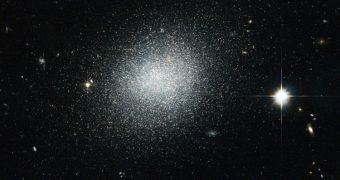Astronomers operating the NASA/ESA Hubble Space Telescope have recently released an impressive new view of UGC 5497, a so-called compact blue dwarf galaxy that contains a large number of newly formed star clusters.
Snapped using the Advanced Camera for Surveys (ACS) instrument aboard the iconic observatory, the new image covers a field of view of about 3.4 by 3.4 arcminutes, and combines near-infrared and optical wavelengths in a single, composite image.
The entirety of the compact galaxy is clearly visible across the dark background, allowing astronomers to observe the structure and arrangement of numerous star clusters inside the formation. By studying UGC 5497, experts hope to gain new insights into the nature of these objects.
According to the team that conducted the new observations, the galaxy appears to have a bluish color on account of all the new stars its clusters contain. When they first collapse from massive hydrogen clouds, protostars tend to emit light towards the ultraviolet region of the electromagnetic spectrum.
When looking at an image of a galaxy, the prevailing color can give a lot of insight into the age of the formation, as well as the distance it lies from Earth. Interestingly, most of the stars in the compact galaxy are massive, which means that UGC 5497 will not retain its appearance for long.
These fast-lived stars only remain stable for a few million years, before they start exploding as supernovae. When this happens, they will start dispersing the gas currently fueling the formation of other stars, and the galaxy will stop growing.
“UGC 5497 is considered part of the M 81 group of galaxies, which is located about 12 million light-years away in the constellation Ursa Major (The Great Bear). UGC 5497 turned up in a ground-based telescope survey back in 2008 looking for new dwarf galaxy candidates associated with Messier 81,” a NASA press release reads.
Previously overlooked objects such as this one may be part of the large number of dwarf galaxies estimated to exist around larger formations, such as the Milky Way. At this point, astronomers are trying to figure out why they cannot see these objects.
The Lambda Cold Dark Matter model of galaxy formation – the most widely accepted today – holds that large and massive galaxies should have tens or hundreds of dwarf galaxies orbiting them. However, observations conducted thus far failed to reveal such large numbers of satellites.

 14 DAY TRIAL //
14 DAY TRIAL //